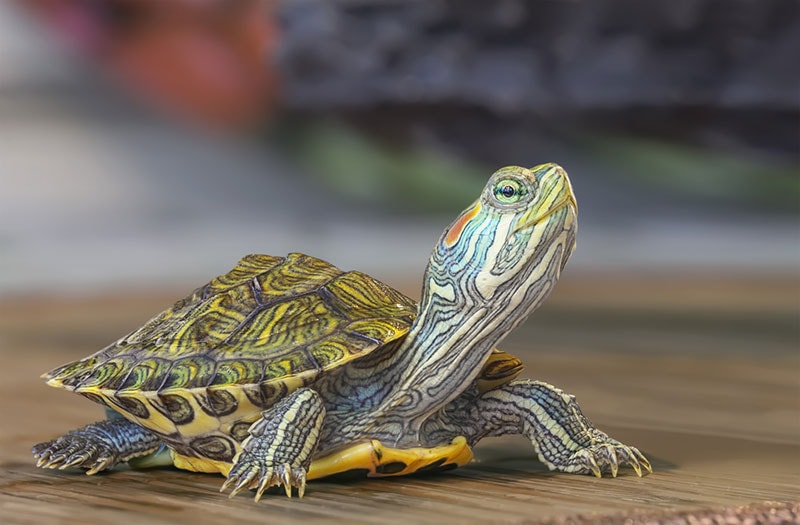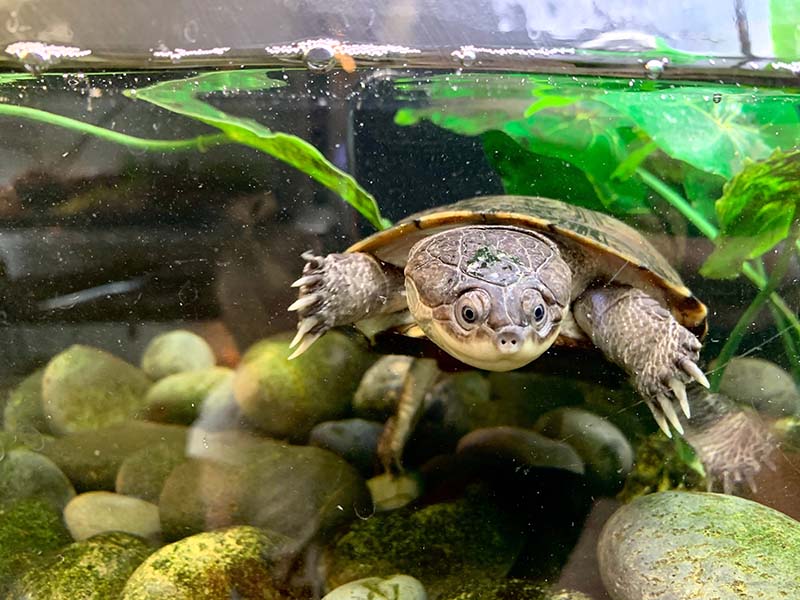Eastern Box Turtle: Pictures, Facts, Diet & Care Guide

Updated on

Click to Skip Ahead
Eastern Box Turtles are native to the eastern United States and are a subspecies of the common Box Turtle. Their numbers are in decline, possibly due to their low reproduction rate and how slowly they move, which puts them at risk of being hit by cars and agricultural equipment.
They’re found in various habitats in the wild, from dry fields to damp forests. They don’t spend much time in the water but will venture into shallow waters. Their adaptability makes them fairly easy to house as pets, but they require specialized care. With the proper knowledge behind you, an Eastern Box Turtle will be with you for a long time!
| Size: | Small (4”x6”) |
| Weight: | Less than 1lb |
| Lifespan: | 25–35 years |
| Suitable for: |
Beginners and experienced families, owners with plenty of interior space
|
| Temperament: | Shy, can be playful, docile |
The Eastern Box Turtle has a high-domed brown shell with bright red, orange, and yellow markings that make them stand out. They have been known to live as long as 40 years with the proper care but can live as long as 100 years in the wild. This makes the Eastern Box Turtle a long commitment, so be sure you’re up to it before adopting one.
Eastern Box Turtle Characteristics

How Much Do Eastern Box Turtles Cost?
Eastern Box Turtles can cost $140 to $300, depending on age, which means it isn’t the most expensive subspecies of box turtle but is still quite pricey. Their higher price is also due to their low reproduction rate; with fewer babies available, the higher the cost can be.
The price of the turtle is only one part of your initial cost, as is the case with any new pet. You’ll need an aquarium and filter, pebbles and substrate, heat lamps, plants, food, a thermometer, and a veterinarian experienced with turtles. This means your initial cost can be in the region of $450 plus.
If you are in the market for an Eastern Box Turtle, you might be able to get one from a pet store, which will probably be cheaper. But the best option is a breeder since they understand how to raise the babies properly. We recommend meeting with a breeder first, and they will also be able to offer you the best advice for getting set up.
Eastern Box Turtle Behavior
Eastern Box Turtles are generally active during the day and spend their time foraging for food and roaming about. We have rated the trainability of this turtle higher than you might expect because while they don’t like being handled as they find it stressful, they can grow to get used to it.
Gentle handling will get them used to you and comfortable with you being near them, which is important because you don’t want them to be stressed when you take them to the vet or clean their tank.
They are shy, docile turtles, but many owners have witnessed their unique personalities and subtle social behavior. They can grow accustomed to the sound of their favorite human’s voice and have even been known to beg for food and play with toys like a small ball.
Do These Turtles Make Good Pets?
Eastern Box Turtles are fantastic pets because they’re suitable for experienced owners or people with little to no experience with owning a turtle. They aren’t considered high-maintenance pets and will bond with you if you are gentle and kind.
They require a firm commitment since they live so long, and it is not a relationship you can enter into half-heartedly. And, of course, it’s important that you learn about all the necessary requirements of owning a turtle to ensure they live a long, happy, and healthy life.
Eastern Box Turtle Breed Tank Mates
An Eastern Box Turtle will get along with another Eastern Box Turtle, but their sex is a factor to consider. Females get along with other females, but an adult male housed with another male will stress the weaker one out by fighting with them. These fights can become bloody and injure one or both of the turtles.
Some owners have mentioned that one male with more than one female works out since a male with only one female results in him focusing all his attention on her, which stresses her out and might result in the female going off her food and becoming ill. Any species other than a turtle placed in a Box Turtle’s tank will become food. Box Turtles generally don’t need a tank mate to be happy and can live independently.
Care Sheet & Habitat Setup:
When caring for your Eastern Box Turtle, their tank setup is crucial, and it’s incredibly important that you get it right. So, let’s look at everything you’ll need to know.
Light Requirements
Sunlight is the best option for your Eastern Box Turtle’s vitamin D production, so if they are kept indoors, you will need to replicate the sun with a UVB-emitting reptile light which you will usually stay on for around 10 to 12 hours a day. You only have to change the bulbs every 6 to 9 months. Even if the light continues to switch on, it will eventually stop emitting UV light, so it’s important to follow the instructions and replace it on time.
Tank Size
The Eastern Box Turtle requires a lot of space to move around, so you’ll need a tank with a minimum of 4 square feet that is 18 inches tall.
The ideal setup is outdoors to mimic how your turtle would live in the wild. However, you will need a pen to protect them from predators and harsh weather. There should be shady and sunny spots, and you should provide them with clean soil so they can dig. All plants provided should be turtle-safe and pesticide-free.
Ensure they always have access to two shallow pans of water to soak in and drink from, which must be refreshed at least once daily. You will need to remove dirty litter weekly and spot clean the tank daily.

Temperature
Your Eastern Box Turtle needs a sunny spot to bask in that will be around 85° to 88°F. A shaded spot should also be at around 75°F, which should never dip below 70°F. If it’s colder than this at any point, you will need to bring your turtle inside and provide them with a heat lamp.
The ideal environment is humid, and 70% to 80% humidity can be achieved with daily misting or an automatic fogger. The shallow pools of water will also help achieve their desired humidity levels.
Plants
Plants can provide your turtle with food and something to hide under. There are a variety of plants you can put into their tanks, such as:
- Alfalfa
- Clover
- Collard greens
- Ferns: Great for shade
- Mosses: Excellent for layering with substrate and helps retain humidity and moisture
- Variety of leaf lettuces: Except iceberg and romaine
Make sure you research plants before putting them in because some can be harmful in large amounts or toxic in any amount.
Substrate
The substrate is used as bedding in the bottom of your Eastern Box Turtle’s pen, which will mirror their natural environment. Pelleted, mulch, or a mossy substrate are suitable for your turtle since they will increase the habitat’s humidity and also retain moisture. The substrate will need to be deep enough for them to burrow into.
Filtration
Eastern Box Turtles are messy and require frequent cleaning. The best option for the tank is a canister filter. It attaches next to or underneath the aquarium, maximizing the space. They have a multilevel filtration system that can keep up with the amount of waste your turtle will produce.
Things to Know When Owning an Eastern Box Turtle:
Food & Diet Requirements
As omnivores, Eastern Box Turtles will eat various things in the wild, and you should keep their diet as close as possible to their wild one. Generally, they should be fed in the morning as they’re most active during the day, and they need to be fed every 24 hours.
About half of this turtle’s diet will be made up of vegetables, grasses or hay, and some fruit. They like bright colors and will be tempted by red bell peppers or tomatoes. The rest of their diet can come from low-fat, live insects, such as snails, slugs, crickets, earthworms, grasshoppers, and mealworms.
The protein they require will depend on their age, and younger turtles need more than adults. They also require a calcium supplement to keep their shells strong and healthy. Your vet can give you the exact quantity that is right for your turtle based on their size and age.
While they aren’t aquatic turtles, they will wade in their water, so it’s important to look out for dirt and droppings and refresh it as needed throughout the day.
Size & Growth Chart
Many factors, such as genetics, diet, and UVB exposure will affect your Eastern Box Turtle’s size. So, it’s important they get the proper care to meet their needs so they grow up strong and healthy.
Below, we’ve included a growth chart, but if you are ever worried about the development of your turtle, contact your vet for advice.
| Age | Average Shell Length |
| Hatchling | 1–2” |
| 6 months | 2” |
| 1 year | 2–3” |
| 2–3 years | 3–5″ |
| 4–6 years | 5–6” |
Lifespan and Health Conditions
As mentioned, Eastern Box Turtles live a long time and are not a short-term commitment. To ensure they live a long, healthy life, you should keep up with scheduled vet visits, research their required care, and implement a routine.
Even if your turtle appears healthy at first, your scheduled vet visits will catch problems or potential issues early and save your turtle from health issues down the line. Your vet might also recommend getting an annual bloodwork and fecal exam to check their overall health and for parasites, which is especially important if your turtle lives outdoors.
Gastrointestinal parasites are common, and signs include abnormal feces and a lack of appetite. Vets also frequently see respiratory infections in Eastern Box Turtles, which are generally caused by a dry or cold environment. Signs of these include bubbles in the nose or mouth, labored breathing, and mucus around the nose and eyes.
Eastern Box Turtles can also develop problems with their shells, like ulcers or shell rot, which are generally caused by an unsanitary habitat or poor diet.
- Vitamin A deficiency
- Shell fractures
- Parasites
- Respiratory infections
- Abscesses
- Shell infections
Male vs Female
Male Eastern Box Turtles tend to be brighter, with red or orange eyes, while the females have brown eyes. Males will also have larger shells, and long thick claws, while females have a higher domed shell and shorter, thinner claws.
Males are known to be more aggressive than females and will spar with competing males, which involves biting other males’ shells. Females don’t fight with other turtles and can hold sperm for up to 4 years.

3 Little-Known Facts About Eastern Box Turtles
1. They Can Close Their Shells
When Eastern Box Turtles are frightened, they can pull hinged sections of their shells shut, which effectively closes them into their shells.
2. Their Shells Can Regenerate Over Time
Over time, the Eastern Box Turtle’s shell can regenerate, with damaged areas falling off as new tissue grows.
3. Wild Turtles Don’t Adjust to Being Caught
If you’re considering getting an Eastern Box Turtle, it’s best to go to a breeder. Wild turtles don’t cope with being caught, and many will die from the stress of captivity. You could also try local rescue groups; they will take them in when owners realize they can’t keep them for their entire lifespan.
Final Thoughts
You might be here out of curiosity, but if you’re considering getting an Eastern Box Turtle, we hope this has helped you make a decision. Although they require a lot of space, Eastern Box Turtles are easy to care for.
They are known to be docile and shy but also warm up to their owners once they get to know them. They have unique personalities that you can take your time getting acquainted with, and if you have a slightly more outgoing one, you might even get in some playtime with them!
Featured Image Credit: Mike Wilhelm, Shutterstock












